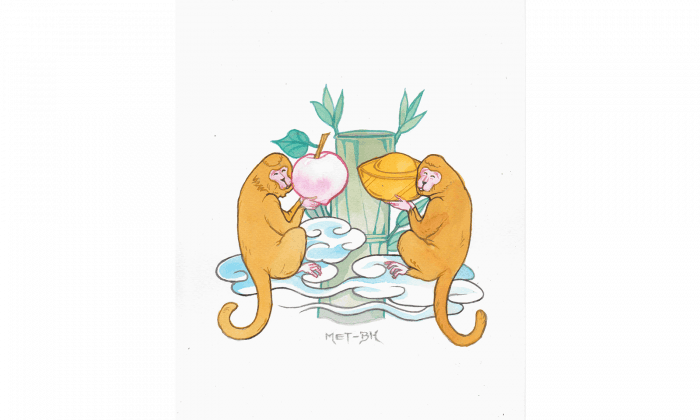Stories about the Three Kingdoms period are so popular that, for hundreds of years, the characters and their legends have been household names and a nostalgic source for life lessons.
There are several idiomatic two-part expressions called xiehouyu(1) (歇後語) that are related to stories about Zhang Fei, some of which directly reference him. “Zhang Fei threads a needle” is one of the most well-known and widely used such expressions.
The idiom 張飛穿針—粗中有細 (Zhāng Fēi chuān zhēn, cū zhōng yǒu xì) is based on a story from Zhang Fei’s youth. The first part, 張飛穿針, or Zhang Fei threads a needle, is a riddle, while the second part, 粗中有細, translates roughly as “coarse yet with some finesse” and answers with the result of Zhang Fei’s task.
When he was young, Zhang Fei studied under Wang Yangnian, who was very knowledgeable in both martial arts and culture. Wang played an important role in forming Zhang’s character.
When Wang Yangnian assessed the young Zhang Fei’s personality traits—bold, fierce, resolute, impulsive, crude, and somewhat unruly, he decided to teach the young man how to be more balanced.
He gave Zhang Fei an assignment to daily thread the little needles that ladies used to embroider. At first, Zhang Fei looked at the tiny hole in the needle with wide eyes and didn’t know what to do. Unable to thread the needle, he would shout angrily about his clumsiness.
Wang Yangnian watched patiently by his side, saying, “The needle has a small ‘eye,’ and you have two large eyes, but you just don’t have ‘an eye in your heart’ [a reference to xinyan, cleverness].”
“If you want to be a general, of course you need to learn how to fight, but you also need to study culture. Then you can defeat your enemies by using both your outstanding martial skills and exceptional strategy. ”
With that, Wang Yangnian took the needle himself and, step by step, showed Zhang Fei how to thread it. Then he said to Zhang Fei, “No hurry. If you cannot get the thread through the needle today, you can try it again tomorrow; if tomorrow you still cannot do it, you can try it the next day. From now on, no matter what you do, just think twice and be smart.”
Every day, Zhang Fei would sit in his room practicing threading the needles, and he slowly became calmer. This training helped to forge his character. He was careless in small matters but became smart about larger issues and strategies; brash and rough most times, but sometimes capable of great subtlety.
Although Zhang Fei was famous for being an unrefined yet brave and formidable warrior, the clever strategies he devised in battle from time to time contributed to his great military achievements as well as to his success as a magistrate.
While the first part of the idiom “ZhangFei threads a needle” serves as the pun or riddle, the second part suggests that there is finesse even in someone’s coarseness, as in the result of Zhang Fei’s character being refined through his task.
This idiomatic, two-part expression is often used to describe people who are crude in most matters, but subtle in some others or who are usually careless, but mindful at times.
Sometimes, the second part, 粗中有細 (cū zhōng yǒu xì) is used independently to express the entire idea. It is sometimes translated as crude and unrefined, yet serves as the answer to the riddle about why Zhang Fei threaded the needle.
Note: Xiehouyu are allegorical sayings that are often an exchange between two people. One person confronts another with the first phrase, which is usually descriptive. The recipient spontaneously follows with the second half—the message. One way to describe their use is the gentle admonitions in parent/child interactions.




